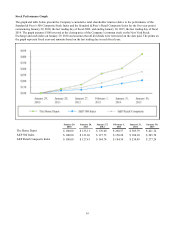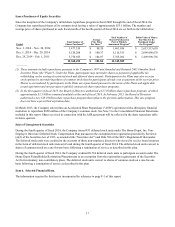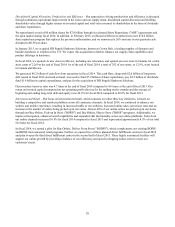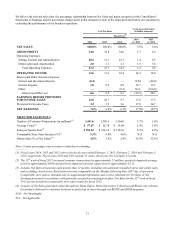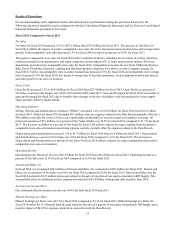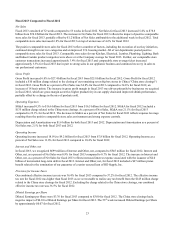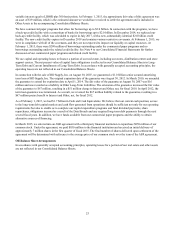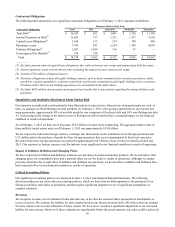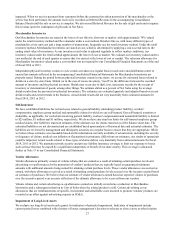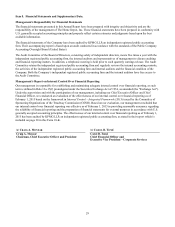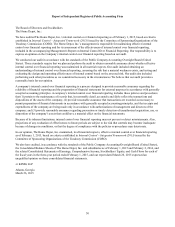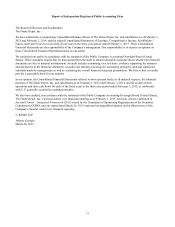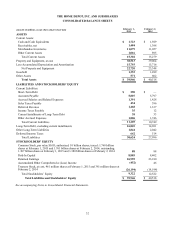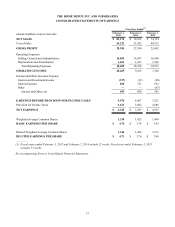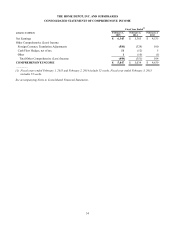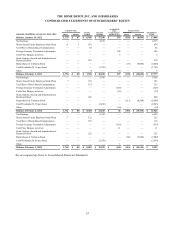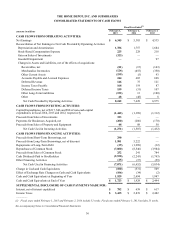Home Depot 2014 Annual Report Download - page 31
Download and view the complete annual report
Please find page 31 of the 2014 Home Depot annual report below. You can navigate through the pages in the report by either clicking on the pages listed below, or by using the keyword search tool below to find specific information within the annual report.
26
Contractual Obligations
The following table summarizes our significant contractual obligations as of February 1, 2015 (amounts in millions):
Payments Due by Fiscal Year
Contractual Obligations Total 2015 2016-2017 2018-2019 Thereafter
Total Debt(1) $ 16,543 $ 292 $ 3,001 $ 2,150 $ 11,100
Interest Payments on Debt(2) 11,603 717 1,231 1,127 8,528
Capital Lease Obligations(3) 1,410 113 219 198 880
Operating Leases 7,705 893 1,554 1,199 4,059
Purchase Obligations(4) 1,203 1,020 116 67 —
Unrecognized Tax Benefits(5) 270 270 — — —
Total $ 38,734 $ 3,305 $ 6,121 $ 4,741 $ 24,567
—————
(1) Excludes present value of capital lease obligations, fair value of interest rate swaps and unamortized debt discounts.
(2) Interest payments are at current interest rates including the impact of active interest rate swaps.
(3) Includes $726 million of imputed interest.
(4) Purchase obligations include all legally binding contracts such as firm commitments for inventory purchases, utility
purchases, capital expenditures, software acquisitions and license commitments and legally binding service contracts.
Purchase orders that are not binding agreements are excluded from the table above.
(5) Excludes $495 million of noncurrent unrecognized tax benefits due to uncertainty regarding the timing of future cash
payments.
Quantitative and Qualitative Disclosures About Market Risk
Our exposure to market risk results primarily from fluctuations in interest rates. Interest rate swap agreements are used, at
times, to manage our fixed/floating rate debt portfolio. At February 1, 2015, after giving consideration to our interest rate
swap agreements, approximately 90% of our debt portfolio was comprised of fixed-rate debt and 10% was floating-rate debt.
A 1.0 percentage point change in the interest costs of floating-rate debt would not have a material impact on our financial
condition or results of operations.
As of February 1, 2015 we had, net of discounts, $16.2 billion of senior notes outstanding. The aggregate market value of
these publicly traded senior notes as of February 1, 2015 was approximately $19.0 billion.
We are exposed to risks from foreign currency exchange rate fluctuations on the translation of our foreign operations into
U.S. dollars and on the purchase of goods by these foreign operations that are not denominated in their local currencies.
Revenues from these foreign operations accounted for approximately $8.5 billion of our revenue in both fiscal 2014 and
2013. Our exposure to foreign currency rate fluctuations is not significant to our financial condition or results of operations.
Impact of Inflation, Deflation and Changing Prices
We have experienced inflation and deflation related to our purchase of certain commodity products. We do not believe that
changing prices for commodities have had a material effect on our Net Sales or results of operations. Although we cannot
precisely determine the overall effect of inflation and deflation on operations, we do not believe inflation and deflation have
had a material effect on our financial condition or results of operations.
Critical Accounting Policies
Our significant accounting policies are disclosed in Note 1 to the Consolidated Financial Statements. The following
discussion addresses our most critical accounting policies, which are those that are both important to the portrayal of our
financial condition and results of operations and that require significant judgment or use of significant assumptions or
complex estimates.
Revenues
We recognize revenue, net of estimated returns and sales tax, at the time the customer takes possession of merchandise or
receives services. We estimate the liability for sales returns based on our historical return levels. We believe that our estimate
for sales returns is an accurate reflection of future returns. We have never recorded a significant adjustment to our estimated
liability for sales returns. However, if these estimates are significantly below the actual amounts, our sales could be adversely


